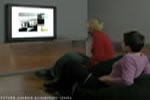 |
|
 |
|
 |
|
|
|
 |
|
 |
|
| Although its highly social
nature (people exchanging code, collaborating on projects together,
treating audiences as equal participants, etc.) aligns “software
art” with contemporary art, since it is firmly focused on its
medium rather than medium-free concepts, “software art”
cannot be considered “contemporary art.” This
is one reason why it is indeed excluded by the art world. The logics
of “contemporary art” and “digital art” are
fundamentally at odds which each other, and I don’t see any
easy way around this. So, for instance, when Ars
Electronica 2003 program asks “In which direction is artists’
work with the new instruments like algorithms and dynamic systems
transforming the process of artistic creativity?” (festival
program, p. 9), the very assumptions behind such a question put it
outside of the paradigm of contemporary art.
If “software art” does not belong to the cultural field of ‘contemporary art,” does it perhaps follows the earlier logic of artistic modernism? In other words, are we dealing here with a kind of “Modernism ver. 2,” since “software” and “digital artists” clearly spend lots of energy investigating new possibilities offered by digital computers and computer-based networks for representation and social communication and cooperation? This interpretation does not work either. Contrary to what you might have learned in art school, modernist artists were not formalists – at least in first half of a twentieth century. The incredible and unprecedented energy which went during these decades into inventing fundamentally new languages of visual communication, new forms, new artistic concepts of space and time, and so on, was rarely driven by purely formal concerns – i.e. investigating the specificity of a particular medium and purifying it from other influences to create works which did not refer to anything outside themselves (Greenberg). Instead, artists’ inventions were driven by multitude of larger questions and goals – representing absolute values and spiritual life; creating new visual language for a working class; representing the dynamism of contemporary city and the experience of war; representing the concepts of Einstein’s relativity theory; translating principles of engineering into visual communication; and so on. In contrast, today’s “digital artists” are typically proper formalists, with their discussions firmly centered on their particular medium – i.e. software. In short, they are not “new modernists,” because modernists were always committed to larger political, social, and spiritual values. If “digital art” does not qualify as “contemporary art” or “modern art,” does it then belong to “design”? Although some designers today indeed focus their energy on systematically investigating new representational and communication possibilities of digital media – John Maeda and his students being a perfect example – these designers represent a very small percentage of the overall design field. A typical designer simply takes the client’s brief and does something using already established conventions, techniques, and iconography. Thus to identify “digital art” with design is to wrongly assume that contemporary design field as a whole is devoted to “basic research” rather than “applications.” If there is one social field whose logic is similar to the logic
of “digital art,” or “new
media art” in general, in my view this field is not
contemporary art, modern art, or design, but computer science.
Like digital artists, computer scientists working with computer
graphics, multimedia, networking, interfaces and other “cultural”
parts of computer science (as opposed to, say, chip design or computer
architecture) are true formalists – that is, they are investigating
new possibilities for representation, social and human-machine communication.
Like digital artists, these computer scientists routinely translate
their ideas into various working demos and prototypes which often
do not have life outside of their own professional domain: academic
papers, conferences, demo presentations. (However, In contrast to
the works of digital artists, some of these ideas do enter into
mainstream computing and thus have huge impact on culture: think
of GUI, hyperlinking, or World Wide Web). |
At the end of the day, if new media artists want their efforts to have a significant impact on cultural evolution, they indeed to generate not only brilliant images or sounds but more importantly, solid discourse. That is, they need to situate their works in relation to ideas that are not only about the techniques of making these works. The reason that we continue discussing Duchamp’s ready-mades or as Paik’s early TV sculptures as though these works were created today has nothing to do with the artistic and technological skills of these artists – it has to do with their concepts, i.e. the discursive statements these artists were making through their objects. In short, if modern and contemporary art is a particular discourse (or a game) where the statements (or moves) are made via particular kind of material objects identified as “artworks,” digital artists need to treat their works as such statements if they are to enter the larger cultural conversation. This means referring to the historical and presently circulating statements in the fields of contemporary art and/or contemporary culture at large. If brilliant computer images are not supported by equally brilliant cultural ideas, their life span is very limited. Either they are destined to be simply forgotten, the way it happened with the great deal of media art – simply because the software and the hardware they required to run on no longer exists. Alternatively – and it hard to say which fate is worse – they would end up as buttons or plug-ins in mainstream graphics and multimedia software. This the ever-present danger of anybody working on the cutting edge of technology – if the results do not become part of other cultural conversations, they inevitably stay within the field of technology itself: either simply erased by new generations of software and hardware, or incorporated within it as elementary building blocks. In saying all this I don’t want to imply that contemporary art is somehow “better” than digital art. Every culture has a need for different discourses, different statements, and different practices; historically they are distributed differently between different cultural fields. Today, for instance, you will find that the development of new styles is mostly done within the design; the tradition of portraiture (representation of a particular human being) is primary carried on in commercial photography; literature and cinema have taken on the role representing human existence via narratives, which in classical period was the function of theatre; and so on. Some fields within computer science, the research-oriented wing of designers, and digital art are playing their own unique and extremely important role: devising new representational and communication methods and techniques. As for contemporary art, it does not actually have a well-defined role within this cultural division of labor. Rather, it is a field there one can make statements which are not possible to make in all any other field, be it science, media, etc. These statements are unique in terms of their subject matter, how they are arrived at, and how they are presented. Not every contemporary artist fully takes advantage of this unique situation, but the best do. While the fields of contemporary art and digital
art play very different roles and both are culturally important
for different reasons, they are also are both limited in a complementary
way. Contemporary art is too historical: a typical
statement in this field either by artist or by critic inevitably
refers to another statement or statements made during the last few
decades in the field. Digital art has the opposite
illness: it has no memory of its own history, so
it can benefit from remembering its past more systematically. If
the two fields can learn from each other, the results can be very
exciting.
|
|
| Text originally published in ArtFutura's 2003 catalog. | ||

